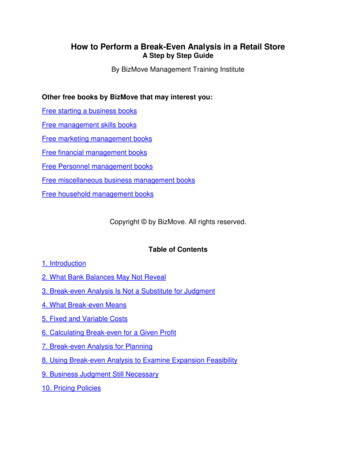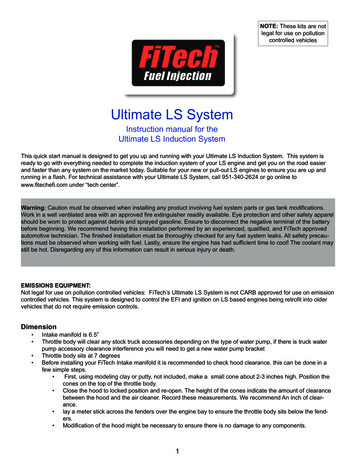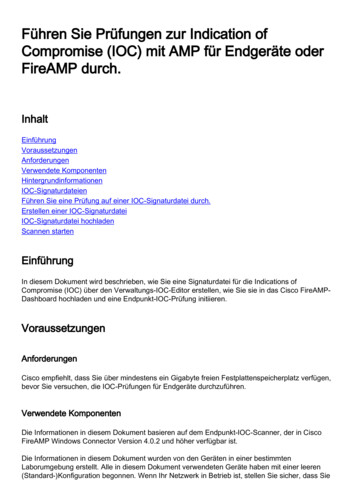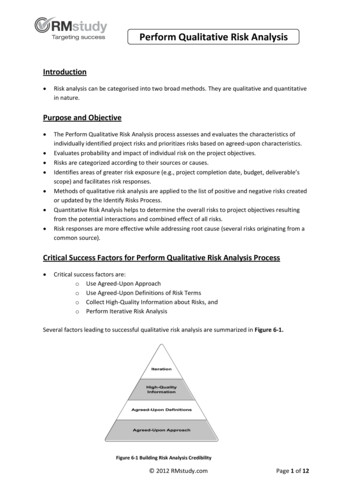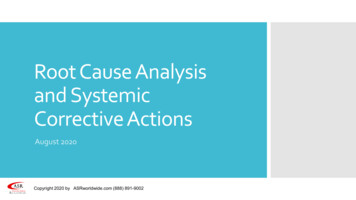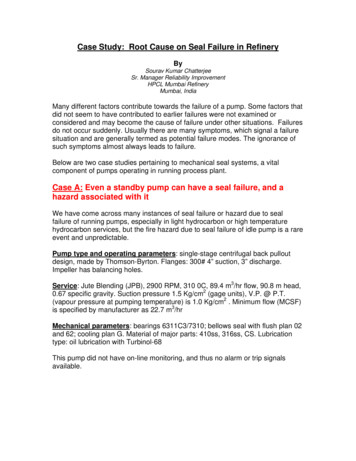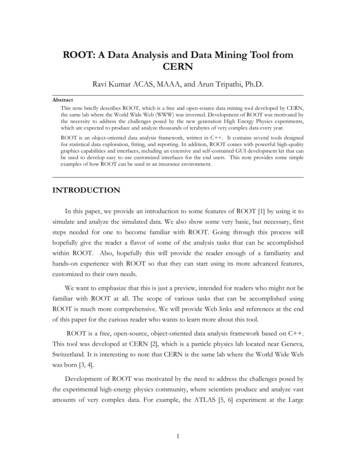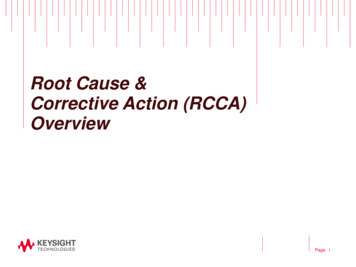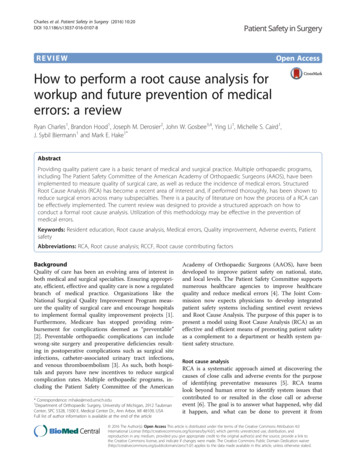
Transcription
Charles et al. Patient Safety in Surgery (2016) 10:20DOI 10.1186/s13037-016-0107-8REVIEWOpen AccessHow to perform a root cause analysis forworkup and future prevention of medicalerrors: a reviewRyan Charles1, Brandon Hood1, Joseph M. Derosier2, John W. Gosbee3,4, Ying Li1, Michelle S. Caird1,J. Sybil Biermann1 and Mark E. Hake1*AbstractProviding quality patient care is a basic tenant of medical and surgical practice. Multiple orthopaedic programs,including The Patient Safety Committee of the American Academy of Orthopaedic Surgeons (AAOS), have beenimplemented to measure quality of surgical care, as well as reduce the incidence of medical errors. StructuredRoot Cause Analysis (RCA) has become a recent area of interest and, if performed thoroughly, has been shown toreduce surgical errors across many subspecialties. There is a paucity of literature on how the process of a RCA canbe effectively implemented. The current review was designed to provide a structured approach on how toconduct a formal root cause analysis. Utilization of this methodology may be effective in the prevention ofmedical errors.Keywords: Resident education, Root cause analysis, Medical errors, Quality improvement, Adverse events, PatientsafetyAbbreviations: RCA, Root cause analysis; RCCF, Root cause contributing factorsBackgroundQuality of care has been an evolving area of interest inboth medical and surgical specialties. Ensuring appropriate, efficient, effective and quality care is now a regulatedbranch of medical practice. Organizations like theNational Surgical Quality Improvement Program measure the quality of surgical care and encourage hospitalsto implement formal quality improvement projects [1].Furthermore, Medicare has stopped providing reimbursement for complications deemed as “preventable”[2]. Preventable orthopaedic complications can includewrong-site surgery and preoperative deficiencies resulting in postoperative complications such as surgical siteinfections, catheter-associated urinary tract infections,and venous thromboembolism [3]. As such, both hospitals and payors have new incentives to reduce surgicalcomplication rates. Multiple orthopaedic programs, including the Patient Safety Committee of the American* Correspondence: mhake@med.umich.edu1Department of Orthopaedic Surgery, University of Michigan, 2912 TaubmanCenter, SPC 5328, 1500 E. Medical Center Dr., Ann Arbor, MI 48109, USAFull list of author information is available at the end of the articleAcademy of Orthopaedic Surgeons (AAOS), have beendeveloped to improve patient safety on national, state,and local levels. The Patient Safety Committee supportsnumerous healthcare agencies to improve healthcarequality and reduce medical errors [4]. The Joint Commission now expects physicians to develop integratedpatient safety systems including sentinel event reviewsand Root Cause Analysis. The purpose of this paper is topresent a model using Root Cause Analysis (RCA) as aneffective and efficient means of promoting patient safetyas a complement to a department or health system patient safety structure.Root cause analysisRCA is a systematic approach aimed at discovering thecauses of close calls and adverse events for the purposeof identifying preventative measures [5]. RCA teamslook beyond human error to identify system issues thatcontributed to or resulted in the close call or adverseevent [6]. The goal is to answer what happened, why didit happen, and what can be done to prevent it from 2016 The Author(s). Open Access This article is distributed under the terms of the Creative Commons Attribution 4.0International License (http://creativecommons.org/licenses/by/4.0/), which permits unrestricted use, distribution, andreproduction in any medium, provided you give appropriate credit to the original author(s) and the source, provide a link tothe Creative Commons license, and indicate if changes were made. The Creative Commons Public Domain Dedication o/1.0/) applies to the data made available in this article, unless otherwise stated.
Charles et al. Patient Safety in Surgery (2016) 10:20happening again? [7, 8]. The process includes documentreviews and interviews with the parties involved in theevent. Flow diagramming, cause and effect diagramming,and identifying root causes and contributing factors helpto organize the events and determine why an error occurred. Based on the root causes and contributing factors,actions can be developed to prevent the error from recurring. Measuring the outcome of an intervention is alsoplanned in order to determine the success of the RCA.Tools to assist the team include triggering questions, thefive rules of causation, and action hierarchy [7].RCA processThe goal of performing an RCA is to protect patients byidentifying and changing factors within the healthcaresystem that can potentially lead to harm. There are 9steps (Table 1) which serve as a guide for performing aneffective RCA. Before a RCA can begin, honest and openreporting of errors is required [9]. A Department shouldstrongly encourage residents, midlevel providers, andfaculty to report adverse events and close calls (or nearmisses). A risk based triaging system should be used toevaluate the report to determine if an RCA is required.At our institution, there is a patient care committeecomprised of faculty and residents who review incidentreports and decide if an event would benefit from anRCA. If an RCA is required, it would be assigned to asmall team consisting of 4 to 6 individuals who havefundamental knowledge of the specific area involved [7].Team members should consist of physicians, supervisors, ancillary staff and quality improvement experts. Itis important that members of the RCA team are not involved in the case being reviewed to ensure objectivity[10, 11]. Time to completion of an RCA varies depending complexity of the case, time required to conduct interviews and synthesize information, and barriers toimplementation of corrective actions; however, a typicalinvestigation should range between one to three months.The next step of the RCA process is to create an “initial flow diagram” depicting the known sequence ofevents leading up to the adverse event being investigated. The purpose of the initial flow diagram is topresent the known facts and serve as a springboard toinvestigate what contributed to each event [12]. Development of a basic flow diagram facilitates a mutual understanding of the event and problem.An extensive list of “triggering questions” provides aclinical context and helps postulate what occurred during the time period in which the adverse event tookplace [13, 14]. Triggering questions serve as cognitiveaids to identify areas of inquiry that may not have beenpreviously considered. The questions cover communication, training, engineering, equipment, rules, policies,procedures, and barriers. To answer these questions, anyPage 2 of 5Table 1 Process of root cause analysis (RCA)Step 1: Identify Adverse Event Honest and open reporting of adverse events Committee review of clinical documentation to understand basics ofwhat event happened? When? Who was involved? How and why didit happen? Identify appropriate RCA investigationsStep 2: Organize a Team Team should consist of 4–6 members of clinicians, supervisors, qualityimprovement experts with fundamental knowledge of specific area ofinterest Ensure that despite members having different levels of authority,everyone should be treated as equals Members should not be directly involved with the case in question Appoint an unbiased team leader/facilitatorStep 3: Develop an Initial Flow Diagram Use a flowchart to describe the processes leading to the event Organizing the information to reach a mutual understanding of theproblemStep 4: Develop an Event Story Map Use of Triggering questions to guide further investigation Conduct thorough interviews with all parties involved in event Thorough review of clinical documentation surrounding the eventStep 5: Develop a Cause and Effect Diagram Identify a single problem statement Identify Actions and Conditions that caused the problem statement These categories should address communication problems, policies,rules, procedures and human errors leading to the eventStep 6: Identify Root Cause Contributing Factors (RCCF) Describe how a cause led to an effect and increased the likelihood ofadverse event Apply 5 rules of causation for crafting RCCF statementsStep 7: Develop Corrective Actions Identify barriers and risk reduction strategies to prevent root causefrom recurring Multiple actions may be required Implement a trial test of corrective actionStep 8: Measure Outcomes Develop outcome measurements to ensure appropriateimplementation of actions Track quantifiable data to document effectiveness of actions over time Evaluate and fine-tune improvement efforts if neededStep 9: Communicate Results Communicate results of RCA to all staff involved in event and morebroadly if applicableindividual who may have contributed to the progressionof the adverse event is subsequently interviewed. Thisincludes attending physicians, residents, mid levelproviders, nursing, engineering, and ancillary staff.The purpose of these questions and ensuing interviews is to identify exactly what occurred, and fill indetails of the initial flow diagram, thus creating an“event story map” (Fig. 1). The event story map conveys in significant detail what happened and why ithappened utilizing the information collected duringthe interview process.Once the Event Story Map is constructed, it is necessary to develop a “cause and effect” diagram. Acause and effect diagram is composed of a problemstatement, an action, and two to three conditions
Charles et al. Patient Safety in Surgery (2016) 10:20Adverse Eventand TimingPage 3 of 5Initial Events Leading toAdverse EventSpecific Events Leadingto Adverse EventAny AdditionalEvents Contributingto Adverse EventFollow Up AfterAdverse EventDiscovery of AdverseEventFig. 1 Event story map creation conveys significant detail of event after chart reviews and personnel interviews[15]. These categories should address communicationproblems, policies, rules, procedures and human errors leading to the event. Each causal event box inthe diagram is connected to the preceding box by a“caused by” statement (Fig. 2). This process is continued until knowledge of the event is exhausted, itbecomes apparent that additional investigation is required, or the causal events identified are too farremoved to be of value. The purpose of crafting acause and effect diagram is to help the teams identifycausal links and ascertain “root cause contributingfactors” (RCCF) for each event.Crafting a RCCF statement begins by describing howsomething (cause), led to something (effect), that increased the likelihood of an undesirable outcome (event)[14]. After the initial RCCF statement or statements arecreated, the “Five Rules of Causation” are applied tofinalize each statement (Table 2) [16, 17]. By correctlycrafting the RCCF statement, the teams’ findings are distilled into one or two sentences that describe whatFig. 2 A Cause and Effect Diagram is read from left to right connected by “caused by” statements. From the cause and effect diagrammingmodel in Apollo Root Cause Analysis by Dean L. Gano [15]
Charles et al. Patient Safety in Surgery (2016) 10:20Page 4 of 53. Human errors must have a preceding cause.national programs have been developed with thepurpose of ensuring quality healthcare. However, theorthopaedic literature is sparse on how to effectively develop and implement quality improvement programs.Our model provides guidance on the development andimplementation of quality improvement initiatives to reduce surgical errors.4. Violations of procedure are not root causes, but must have apreceding cause.AcknowledgementsNot applicable.Table 2 Five rules of causation for root cause contributionfactorFive Rules of Causation1. Clearly show the cause and effect relationship.2. Use specific and accurate descriptors for what occurred, ratherthan negative and vague words.5. Failure to act is only causal when there is a pre-existing dutyto act.happened and why it is important to expend time and/or resources to correct it. This creates a road map leading to the development of corrective actions and theirrespective process or outcome measures. The implementation of these actions is what ultimately improves patient safety.The RCCFs are placed on the event story map before the primary event where there is a system vulnerability that should be addressed. This placementindicates the location where an existing barrier needsto be reinforced or where a new barrier needs to becreated. Ideally there will be RCCFs identified at multiple points along the event story map, which graphically represents how care processes are designed to befault-tolerant.Finalizing an event story map with appropriatelyidentified RCCF statements would be meaningless topatients if it did not lead to action and change. Usingthe RCCF statements, specific actions with the goal ofsustained system improvement are implemented [12,18]. While the implementation of the actions is leftto department and hospital leadership, the RCA teamis responsible for identifying an individual to followthe implementation process and confirm the changeshave in fact been made. A properly crafted process oroutcome measure should be specific, quantifiable, andprovide a timeline on when it is going to assessed[19]. It should clearly tell you if the action that wasimplemented resulted in the desired system change.Finally, corrective actions identified throughout theRCA should be shared amongst appropriate partiesnot only involved in the RCA and adverse event orclose call but also with other hospital staff anddepartments as a means to promote quality improvement [12, 19].ConclusionElimination of medical errors and promotion of pat
model in Apollo Root Cause Analysis by Dean L. Gano [15] Adverse Event and Timing Initial Events Leading to Adverse Event Specific Events Leading to Adverse Event Any Additional Events Contributing to Adverse Event Discovery of Adverse Event Follow Up After Adverse Event Fig. 1 Event story map creation conveys significant detail of event after chart reviews and personnel interviews Charles et .

